Bond Life Sciences Center

April 16, 2015
BPA overrides temperature to decide turtle sex
The environmental build-up of bisphenol A (BPA) can result in a life-changing shift for aquatic animals. For painted turtles, exposure to this chemical can disrupt sexual differentiation,, according to new research in the General and Comparative Endocrinology. Scientists at the University of Missouri have teamed up to show how low levels of certain endocrine disruptors like BPA can cause males to possess female gonadal structures in newly-hatched turtles. This collaboration between MU, Westminster College, the U.S. Geological Survey (USGS) and the Saint Louis Zoo exposed turtle eggs to levels of BPA similar to those currently found in the environment.
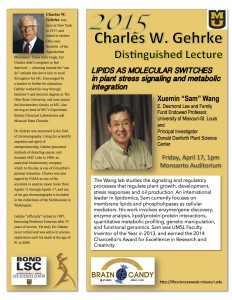
April 9, 2015
Life Sciences Week preview: Doing more with less
A simple virtue lies at the heart of Xuemin (Sam) Wang’s research: thrift. “A good way to think of it is how to increase output without demanding more inputs,” Wang said. Wang, the E. Desmond Lee and Family Fund endowed professor at the University of Missouri-St. Louis and a principal investigator at the Donald Danforth Plant Science Center, studies plant membrane lipids. His lab is focused on understanding the relationship between oil production and plant stresses such as drought and nutrient deficiency. Wang will speak during the 31st annual Missouri Life Sciences Week, a yearly celebration of MU’s…

March 30, 2015
Translating soybean cyst nematode research
Roger Meissen/Bond Life Sciences Center – These soybean roots show some nematode cysts. The small, white circles are the hardened body of the nematodes and form when the nematode attaches itself to the root to create a feeding cell. Beneath a North Carolina field in 1954, a tiny worm inched its way through the soil and butted against a soybean root. The worm pierced the plant, slipped inside and inserted a needle-like appendage into a cell. It pumped a mixture of proteins into the root cell and waited for the potent blend to take effect on…
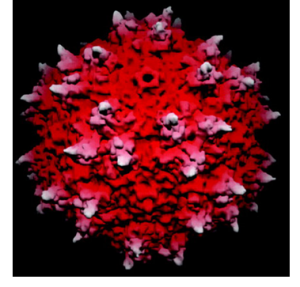
Feb. 12, 2015
Big discoveries come in little (capsid) packages
Adeno-associated virus type 2 at 3.0 A (xie, et al, Proc Natl Acad Sci U S A. 2002; 99:10405-10.) Courtesy David Pintel It’s an understatement to say viruses are small. But an average virus dwarfs the diminutive variety known as parvoviruses, which are among the most minuscule pathogens known to science. Tucked inside a protective protein shell, or capsid, parvoviruses contain a single DNA strand of about 5,000 nucleotides. If parvo’s genetic material is like an hour-long stroll around your neighborhood, a bigger virus like herpes is equivalent to walking from St. Louis to Columbia, Missouri.

Nov. 20, 2014
“Mutant seeds” blossom in the pollen research field
A mutant arabidopsis model nearing pollination. Mutant arabidopsis models under lamps in Shuqun Zhang’s lab. Three-month-old mutant arabidopsis models are used to study the function of pollen. The thought of pollen dispersed throughout the air might trigger horrific memories of allergies, but the drifting dander is absolutely essential to all life. Science has long linked this element of reproduction with environmental conditions, but the reasons why and how pollen functions were less understood. Now lingering questions about the nuanced control of plants are being answered. “Pollen is a very important part of the reproductive process and…

Oct. 9, 2014
The only thing you need to read about Ebola today: An expert Q&A
Jingyou Yu, a graduate student, does cell surface staining in Shan-Lu Liu’s virology lab. The staining illuminates cell marker expressions in experiments that deduce how viruses spread once they are contracted. | Paige Blankenbuehler News headlines seem to feverishly spread as if they were a pandemic of the brain. Ebola hemorrhagic fever has been the most talked about disease of the year, appearing in thousands of headlines across the world since May. Through the noise of misinformation and sensationalism, fundamental information about the pandemic becomes harder to distinguish. In an interview with Decoding Science on Tuesday, Shan-Lu Liu, MD,…
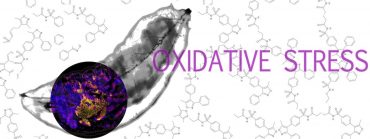
Oct. 1, 2014
The search for oxidative stress treatment continues
A yellow light indicates oxidant production in the tissue of a migrating fly larva. Source: Tobias Dick, German Cancer Research Center | Illustration by Paige Blankenbuehler University of Missouri research characterizes a novel compound By Paige Blankenbuehler Your body has an invisible enemy. One that it creates all on it’s own called oxidative stress, long thought of as an underlying cause of some of humanity’s most insidious diseases – cancer, Alzheimer’s, Parkinson’s Disease, cardiovascular disease and diabetes. Every day, our bodies are exposed to harmful free radicals known as reactive oxygen species as a result of our…

Aug. 26, 2014
Holding on: Bond LSC scientist discovers protein prevents release of HIV and other viruses from infected cells
Shan-Lu Liu, Bond LSC scientist and associate professor in the MU School of Medicine’s Department of Molecular Microbiology and Immunology. Courtesy Justin Kelley, University of Missouri Health System. Shan-Lu Liu initially thought it was a mistake when a simple experiment kept failing. But that serendipitous accident led the Bond Life Sciences Center researcher to discover how a protein prevents mature HIV from leaving a cell. Proceedings of the National Academy of Sciences published this research online Aug. 18. “It’s a striking phenomena caused by this particular protein,” Liu said. “The HIV is already assembled inside…

Aug. 4, 2014
Viruses as Vehicles: Finding what drives
Graduate students Yuleam Song and Dan Salamango inoculate a bacteria culture in Johnson’s lab. The inoculation takes a small portion of a virus and multiplies the sample, allowing researchers to custom-make viruses. By Madison Knapp | Bond Life Sciences Center summer intern Modern science has found a way to turn viruses —tiny, dangerous weapons responsible for runny noses, crippling stomach pains and worldwide epidemics such as AIDS— into a tool. Gene therapy centers on the idea that scientists can hijack viruses and use them as vehicles to deliver DNA to organs in the body that…

July 16, 2014
Researchers flex new muscle in SMA drug development
By Paige Blankenbuehler Lauren and Claire Gibbs share contagious laughter, ambition and a charismatic sarcasm. Both are honor students at Shawnee Mission East High School in a Kansas City suburb. They also share a neuromuscular disease called spinal muscular atrophy (SMA), designated as an “orphan disease” because it affects fewer than 200,000 people in the U.S. However, the landscape for individuals with SMA is quickly changing with the development of new drugs. More than 7 million people in the United States are carriers (approximately 1 in 40) of the so-called “rare” neurodegenerative disease, SMA. Lauren,17 (left) and Claire, 16 (right),…
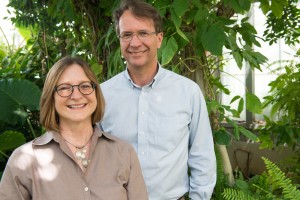
July 1, 2014
Hearing danger: predator vibrations trigger plant chemical defenses
Experiments show chewing vibrations, but not wind or insect song, cause response As the cabbage butterfly caterpillar takes one crescent-shaped bite at a time from the edge of a leaf, it doesn’t go unnoticed. This tiny Arabidopsis mustard plant hears its predator loud and clear as chewing vibrations reverberate through leaves and stems, and it reacts with chemical defenses. Plants have long been known to detect sound, but why they have this ability has remained a mystery. University of Missouri experiments mark the first time scientists have shown that a plant responds to an ecologically relevant sound in its environment. “What…
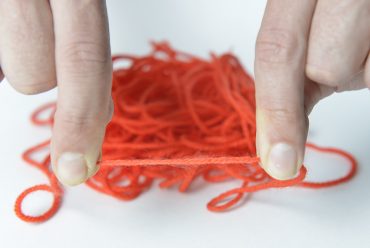
May 12, 2014
New screening tool gives scientists more control over genetic research
A tangled spool of yarn represents DNA, while the fingers holding the section represent the insulators just added by MU researchers to improve a scientific, screening tool. | Paige Blankenbuehler Here’s a scenario: You are trying to find a lost section of string in the world’s most massively tangled spool of yarn. Then try cutting that section of yarn that’s deeply embedded in the mess without inadvertently cutting another or losing track of the piece you’re after. For researchers, this problem is not unlike something they encounter in the study of genetic information in the tangled…
- « Previous
- 1
- 2
- 3
- Next »